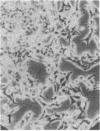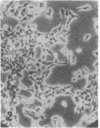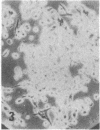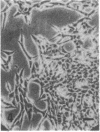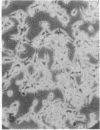Abstract
Nontransformed BALB/3T3 cells were passaged weekly in monolayer culture on plastic dishes and aliquots were regularly assayed for colony production when suspended in agar. During several months of passaging, a single large colony arose once in the agar assay, and its constituent cells were isolated to form a subline of transformed cells. These cells had the fusiform and rounded morphologies characteristic of transformed cells and had a colony-forming efficiency in agar (CFEag) of approximately 10%. Five of the agar colonies were isolated at random and the cell populations of these primary subclones were further analyzed. Four of the five subclonal populations differed from each other in appearance slightly, but consistently, while the fifth had a markedly different colonial morphology. They also differed from one another in CFEag as well as in average diameter of the agar colonies. These general differences among the five subclones remained, although the CFEag and colony sizes changed recognizably in repeated weekly transfers. All of the subclones produced sarcomas in nude mice but did so at different rates. A secondary generation of five subclones was derived from each of three of the original subclonal populations. All the secondary subclones had the same morphology as the primary subclones from which they were derived. The averages of the CFEag and colony sizes of the secondary subclones from each of the subclones differed as a group from the other groups, but they also differed, to a lesser extent, among themselves. Despite the differences noted among the primary subclones in morphology, growth in agar, and tumor production in mice, they were virtually identical in their rapid growth rate on a plastic surface and all shared a high rate of glucose consumption. A second transformed clone arose among the continuously passaged nontransformed cells 5 months after the first one had appeared. Subclones of this clone did not differ recognizably from one another in morphology or in CFEag. The results indicate that recognizable heterogeneity can arise in some tumors during the earliest stages of their development and involve a high proportion of their constituent cells, while it may not become evident in other tumors until much later.
Full text
PDF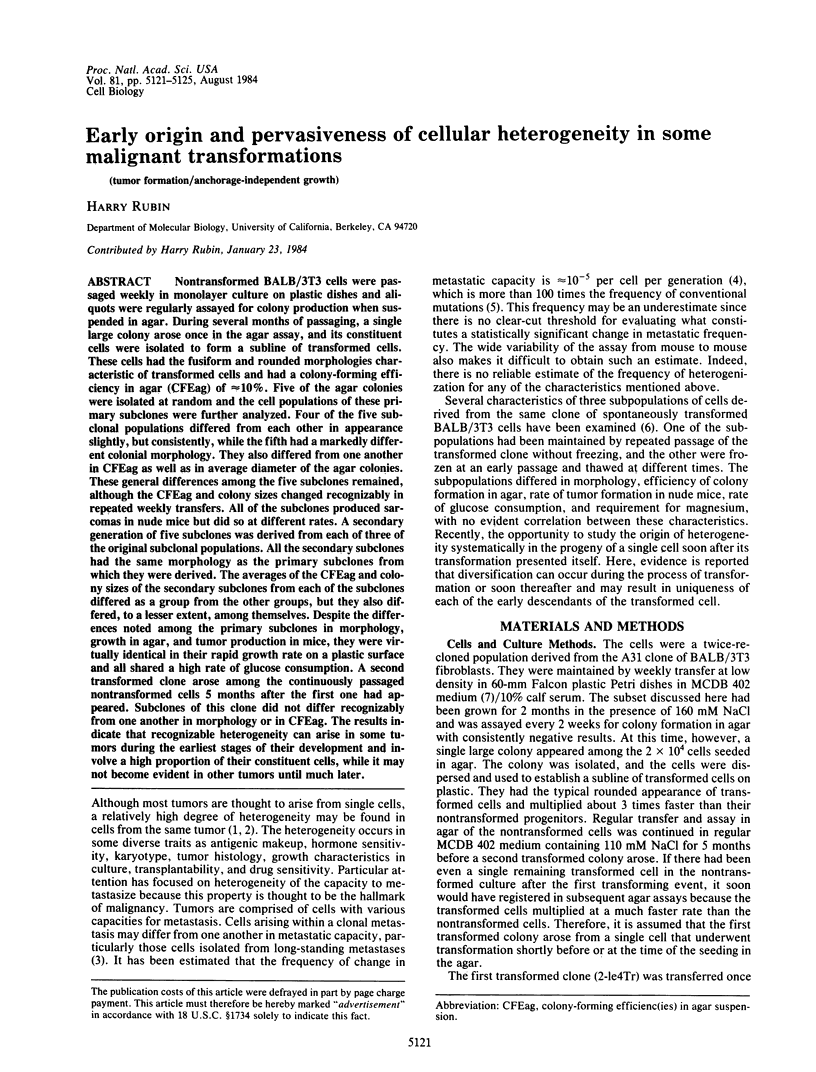
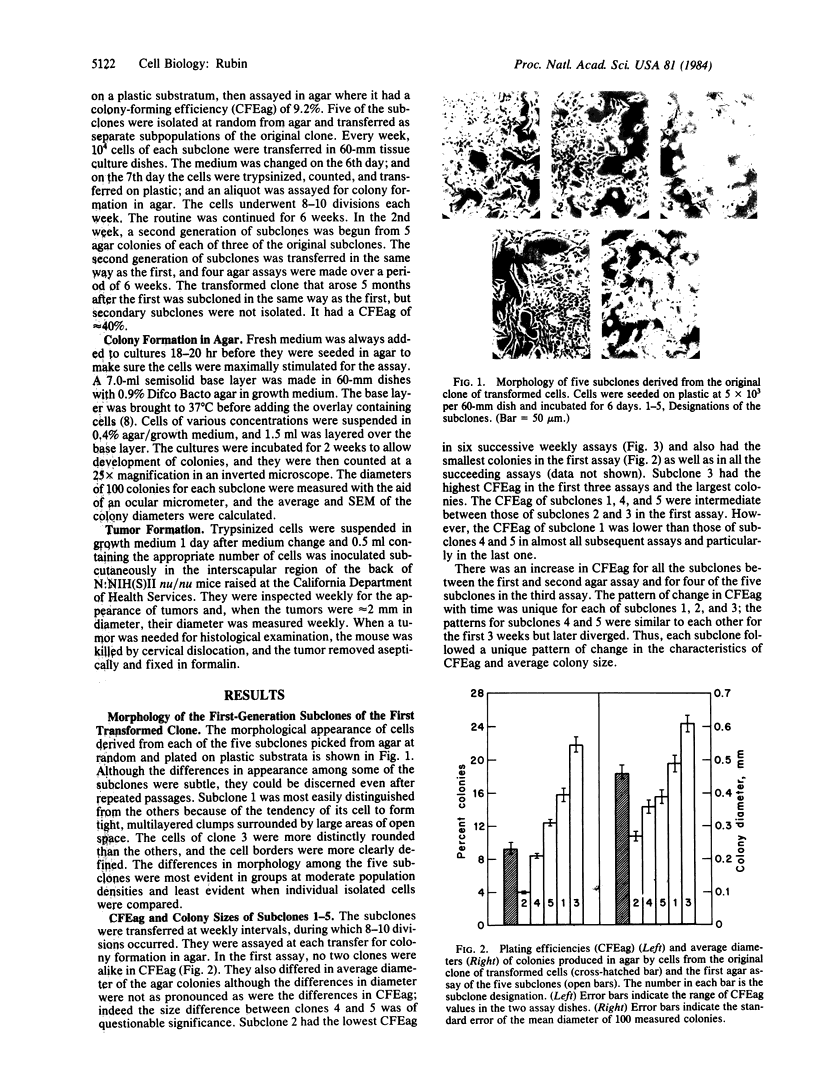
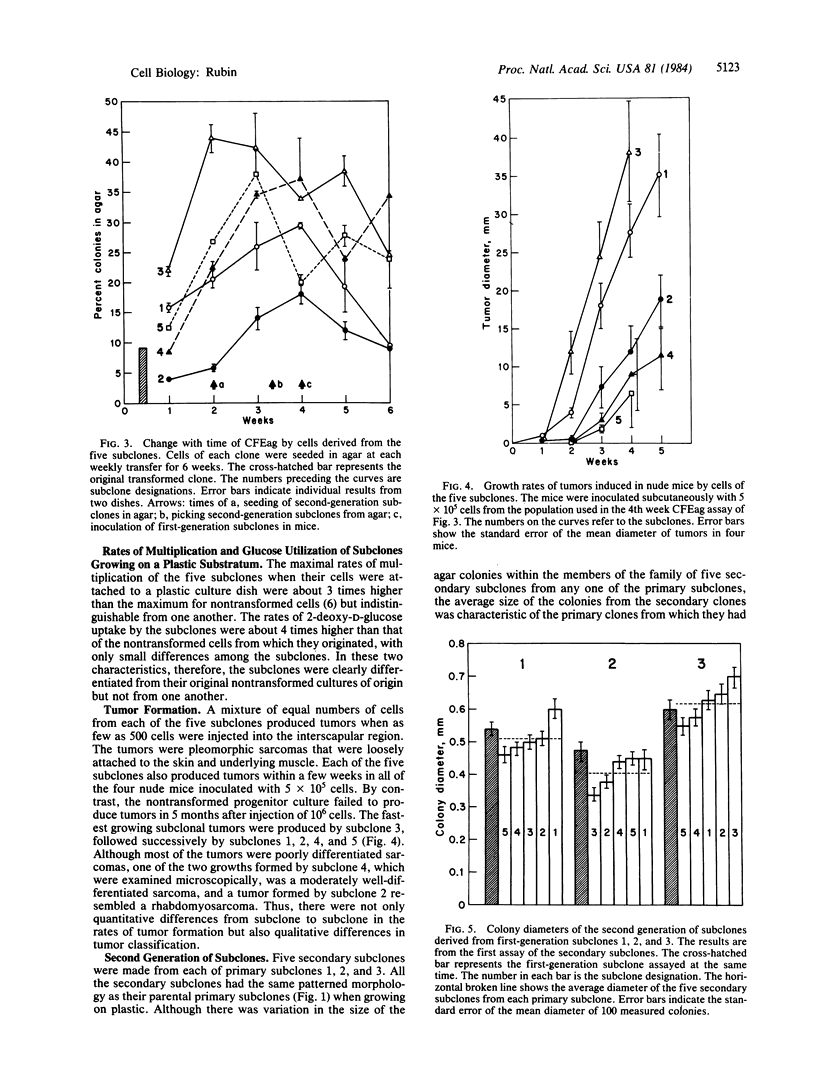
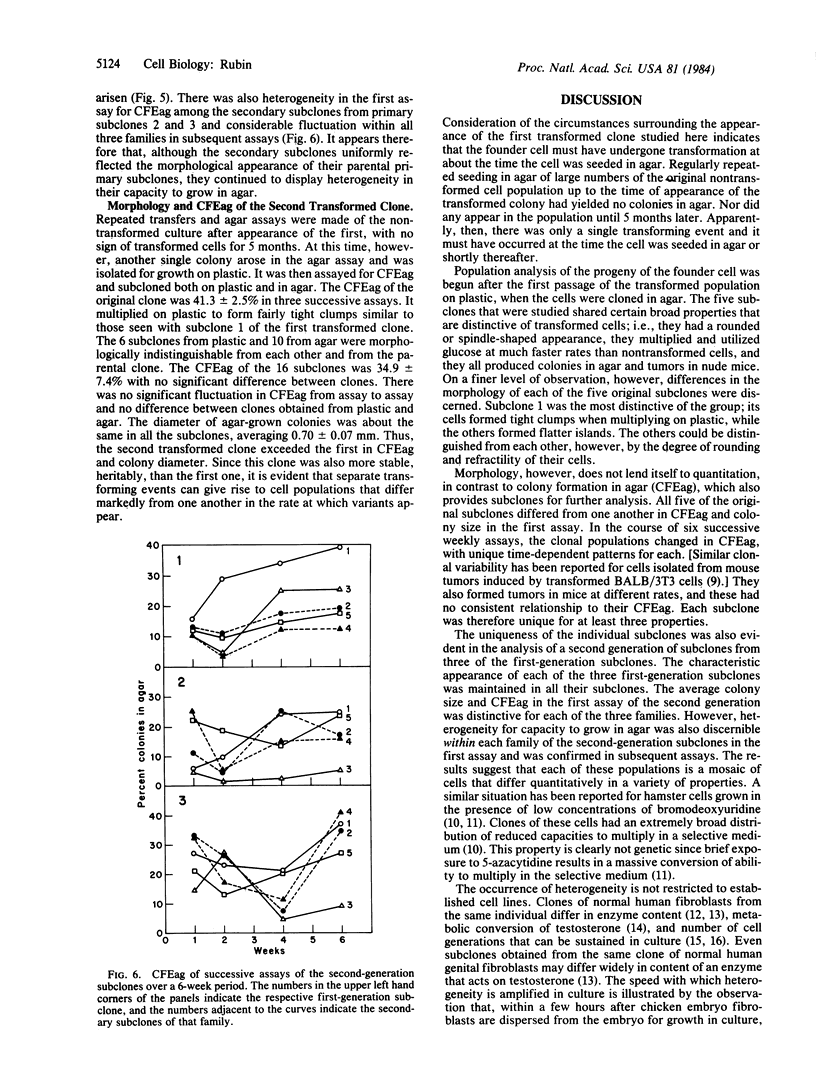
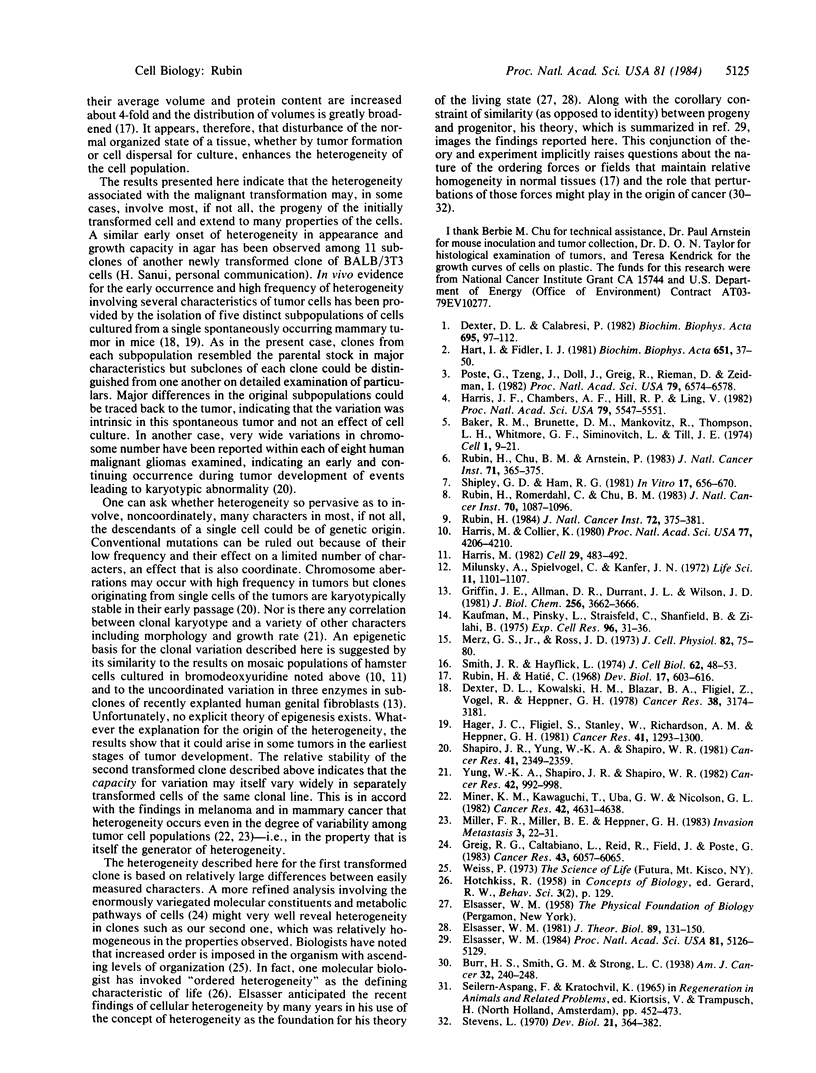
Images in this article
Selected References
These references are in PubMed. This may not be the complete list of references from this article.
- Dexter D. L., Calabresi P. Intraneoplastic diversity. Biochim Biophys Acta. 1982 Dec 21;695(2):97–112. doi: 10.1016/0304-419x(82)90019-1. [DOI] [PubMed] [Google Scholar]
- Dexter D. L., Kowalski H. M., Blazar B. A., Fligiel Z., Vogel R., Heppner G. H. Heterogeneity of tumor cells from a single mouse mammary tumor. Cancer Res. 1978 Oct;38(10):3174–3181. [PubMed] [Google Scholar]
- Elsasser W. M. Outline of a theory of cellular heterogeneity. Proc Natl Acad Sci U S A. 1984 Aug;81(16):5126–5129. doi: 10.1073/pnas.81.16.5126. [DOI] [PMC free article] [PubMed] [Google Scholar]
- Elsasser W. M. Principles of a new biological theory: a summary. J Theor Biol. 1981 Mar 7;89(1):131–150. doi: 10.1016/0022-5193(81)90182-x. [DOI] [PubMed] [Google Scholar]
- Greig R. G., Caltabiano L., Reid R., Jr, Feild J., Poste G. Heterogeneity of protein phosphorylation in metastatic variants of B16 melanoma. Cancer Res. 1983 Dec;43(12 Pt 1):6057–6065. [PubMed] [Google Scholar]
- Griffin J. E., Allman D. R., Durrant J. L., Wilson J. D. Variation in steroid 5 alpha-reductase activity in cloned human skin fibroblasts. Shift in phenotypic expression from high to low activity upon subcloning. J Biol Chem. 1981 Apr 25;256(8):3662–3666. [PubMed] [Google Scholar]
- Hager J. C., Fligiel S., Stanley W., Richardson A. M., Heppner G. H. Characterization of a variant-producing tumor cell line from a heterogeneous strain BALB/cfC3H mouse mammary tumor. Cancer Res. 1981 Apr;41(4):1293–1300. [PubMed] [Google Scholar]
- Harris J. F., Chambers A. F., Hill R. P., Ling V. Metastatic variants are generated spontaneously at a high rate in mouse KHT tumor. Proc Natl Acad Sci U S A. 1982 Sep;79(18):5547–5551. doi: 10.1073/pnas.79.18.5547. [DOI] [PMC free article] [PubMed] [Google Scholar]
- Harris M., Collier K. Phenotypic evolution of cells resistant to bromodeoxyuridine. Proc Natl Acad Sci U S A. 1980 Jul;77(7):4206–4210. doi: 10.1073/pnas.77.7.4206. [DOI] [PMC free article] [PubMed] [Google Scholar]
- Harris M. Induction of thymidine kinase in enzyme-deficient Chinese hamster cells. Cell. 1982 Jun;29(2):483–492. doi: 10.1016/0092-8674(82)90165-9. [DOI] [PubMed] [Google Scholar]
- Hart I. R., Fidler I. J. The implications of tumor heterogeneity for studies on the biology of cancer metastasis. Biochim Biophys Acta. 1981 Aug 31;651(1):37–50. doi: 10.1016/0304-419x(81)90004-4. [DOI] [PubMed] [Google Scholar]
- Kaufman M., Pinsky L., Straisfeld C., Shanfield B., Zilahi B. Qualitative differences in testosterone metabolism as an indication of cellular heterogeneity in fibroblast monolayers derived from human preputial skin. Exp Cell Res. 1975 Nov;96(1):31–36. doi: 10.1016/s0014-4827(75)80033-4. [DOI] [PubMed] [Google Scholar]
- Merz G. S., Jr, Ross J. D. Clone size variation in the human diploid cell strain, WI-38. J Cell Physiol. 1973 Aug;82(1):75–80. doi: 10.1002/jcp.1040820109. [DOI] [PubMed] [Google Scholar]
- Miller F. R., Miller B. E., Heppner G. H. Characterization of metastatic heterogeneity among subpopulations of a single mouse mammary tumor: heterogeneity in phenotypic stability. Invasion Metastasis. 1983;3(1):22–31. [PubMed] [Google Scholar]
- Milunsky A., Spielvogel C., Kanfer J. N. Lysosomal enzyme variations in cultured normal skin fibroblasts. Life Sci II. 1972 Nov 22;11(22):1101–1107. doi: 10.1016/0024-3205(72)90219-6. [DOI] [PubMed] [Google Scholar]
- Miner K. M., Kawaguchi T., Uba G. W., Nicolson G. L. Clonal drift of cell surface, melanogenic, and experimental metastatic properties of in vivo-selected, brain meninges-colonizing murine B16 melanoma. Cancer Res. 1982 Nov;42(11):4631–4638. [PubMed] [Google Scholar]
- Poste G., Tzeng J., Doll J., Greig R., Rieman D., Zeidman I. Evolution of tumor cell heterogeneity during progressive growth of individual lung metastases. Proc Natl Acad Sci U S A. 1982 Nov;79(21):6574–6578. doi: 10.1073/pnas.79.21.6574. [DOI] [PMC free article] [PubMed] [Google Scholar]
- Rubin H. Adaptive changes in spontaneously transformed Balb/3T3 cells during tumor formation and subsequent cultivation. J Natl Cancer Inst. 1984 Feb;72(2):375–381. [PubMed] [Google Scholar]
- Rubin H., Chu B. M., Arnstein P. Heritable variations in growth potential and morphology within a clone of Balb/3T3 cells and their relation to tumor formation. J Natl Cancer Inst. 1983 Aug;71(2):365–375. [PubMed] [Google Scholar]
- Rubin H., Hatié C. Increase in the size of chick embryo cells upon cultivation in serum-containing medium. Dev Biol. 1968 May;17(5):603–616. doi: 10.1016/0012-1606(68)90008-0. [DOI] [PubMed] [Google Scholar]
- Rubin H., Romerdahl C. A., Chu B. M. Colony morphology and heritability of anchorage-independent growth among spontaneously transformed Balb/3T3 cells. J Natl Cancer Inst. 1983 Jun;70(6):1087–1096. [PubMed] [Google Scholar]
- Shapiro J. R., Yung W. K., Shapiro W. R. Isolation, karyotype, and clonal growth of heterogeneous subpopulations of human malignant gliomas. Cancer Res. 1981 Jun;41(6):2349–2359. [PubMed] [Google Scholar]
- Shipley G. D., Ham R. G. Improved medium and culture conditions for clonal growth with minimal serum protein and for enhanced serum-free survival of Swiss 3T3 cells. In Vitro. 1981 Aug;17(8):656–670. doi: 10.1007/BF02628401. [DOI] [PubMed] [Google Scholar]
- Smith J. R., Hayflick L. Variation in the life-span of clones derived from human diploid cell strains. J Cell Biol. 1974 Jul;62(1):48–53. doi: 10.1083/jcb.62.1.48. [DOI] [PMC free article] [PubMed] [Google Scholar]
- Stevens L. C. The development of transplantable teratocarcinomas from intratesticular grafts of pre- and postimplantation mouse embryos. Dev Biol. 1970 Mar;21(3):364–382. doi: 10.1016/0012-1606(70)90130-2. [DOI] [PubMed] [Google Scholar]
- Yung W. K., Shapiro J. R., Shapiro W. R. Heterogeneous chemosensitivities of subpopulations of human glioma cells in culture. Cancer Res. 1982 Mar;42(3):992–998. [PubMed] [Google Scholar]



